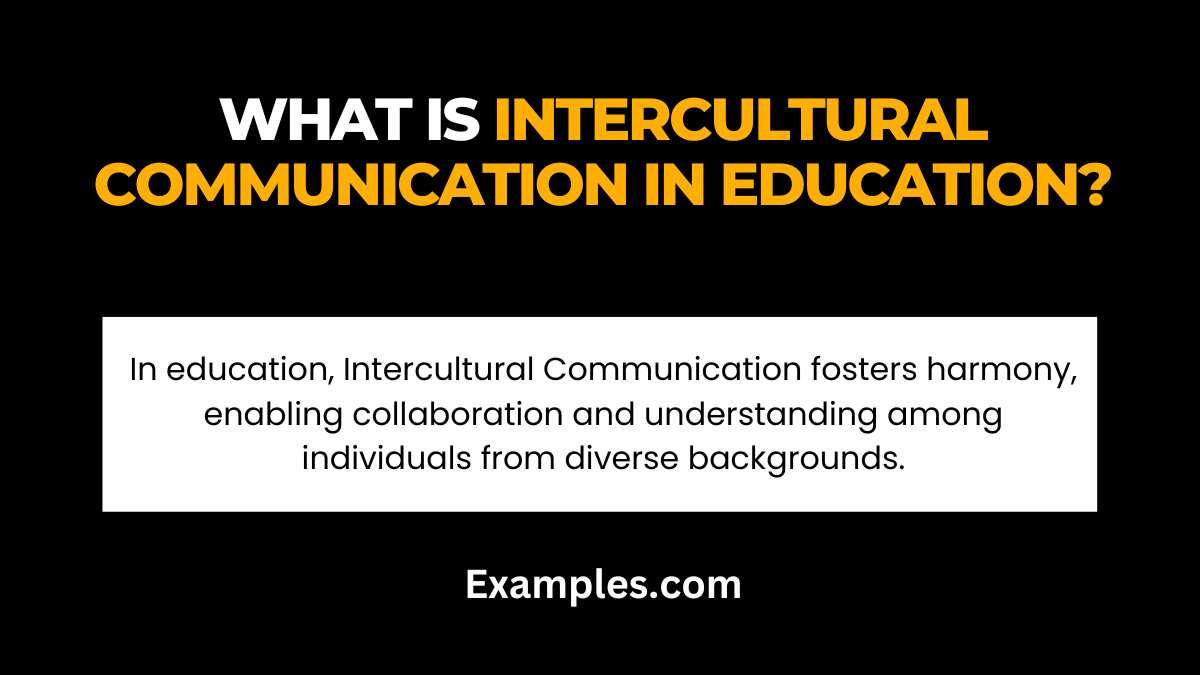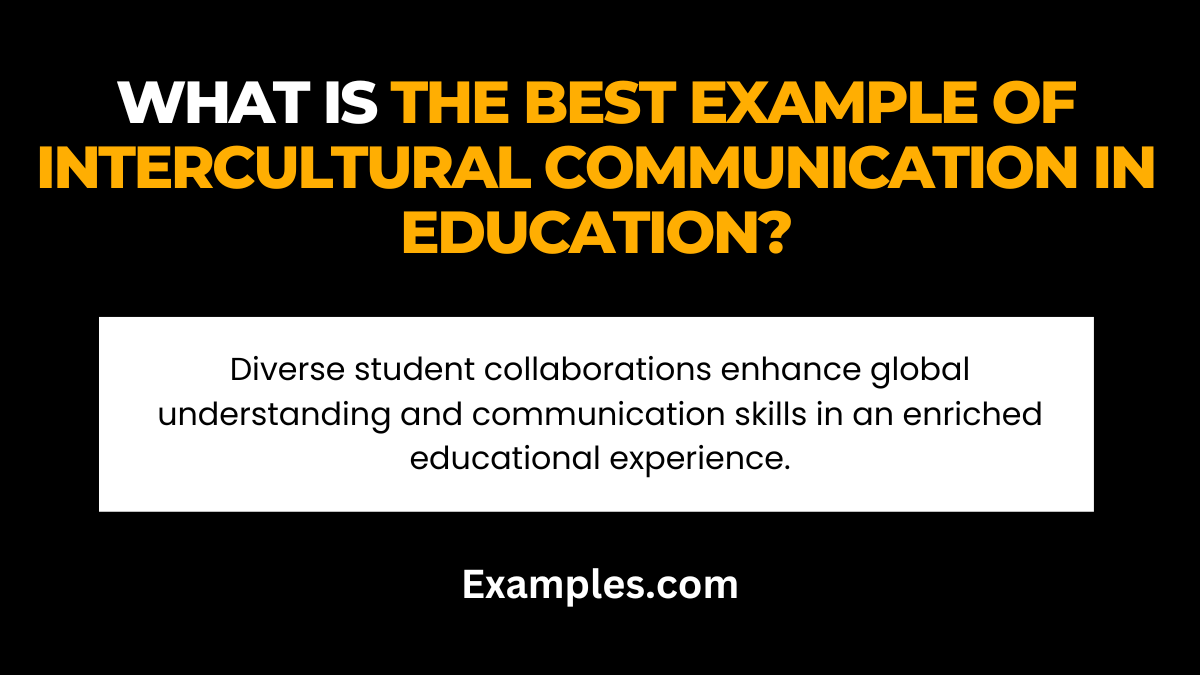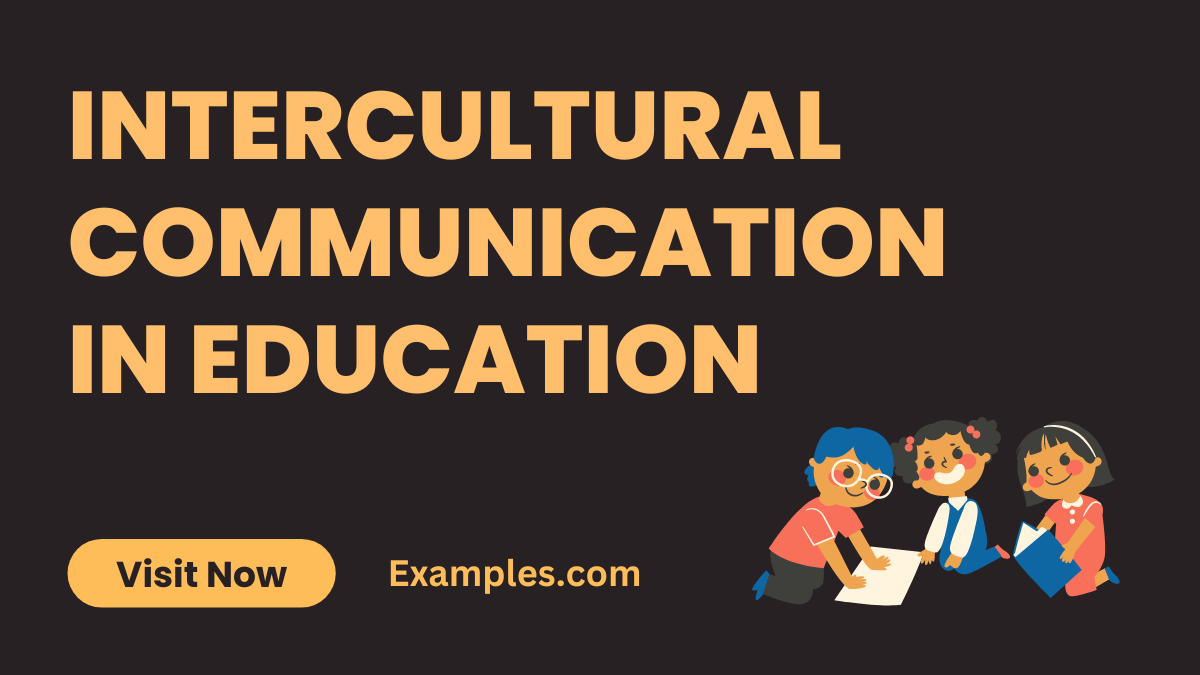29+ Intercultural Communication in Education Examples
Embark on a transformative journey with our “Intercultural Communication in Education” guide. Uncover the significance of fostering inclusive learning environments through real-world Communication Examples. This comprehensive resource not only provides insights into navigating cultural diversity but also equips educators with practical tips to enhance communication and understanding in classrooms, ensuring a rich and globally aware educational experience for both teachers and students alike.
What is Intercultural Communication in Education?

Intercultural Communication in education refers to the exchange of information and ideas among individuals from diverse cultural backgrounds within an educational setting. It involves navigating distinct communication styles, respecting cultural differences, and fostering effective collaboration to create inclusive learning environments. This practice is essential for building a harmonious educational atmosphere, where students and educators from varied cultures can understand, cooperate, and contribute collectively to the educational experience.
What is the best example of Intercultural Communication in Education?

One remarkable example involves collaborative student projects where learners from diverse cultural backgrounds work together. This promotes mutual understanding, appreciation for different perspectives, and the development of essential communication skills. By navigating cultural nuances and fostering teamwork, students not only gain academic knowledge but also acquire valuable intercultural competencies that prepare them for a globally interconnected world. This approach enhances the overall educational experience, contributing to a richer and more inclusive learning environment.
30 Examples of Intercultural Communication in Education

- Multilingual Student Collaborations: Engaging students in collaborative projects where they can communicate in various languages.
- Cross-Cultural Classroom Activities: Designing activities that incorporate diverse cultural perspectives to enrich the learning experience.
- Cultural Sensitivity Training: Implementing training sessions to enhance awareness and understanding of cultural differences.
- Diverse Storytelling: Integrating stories from various cultures to promote diverse narratives in the curriculum.
- Global Pen Pals Program: Connecting students with peers from different parts of the world through letter exchanges.
- International Exchange Programs: Facilitating student exchanges to promote firsthand experiences of different cultures.
- Virtual Cultural Tours: Using technology to take students on virtual tours to explore different cultural landmarks.
- Language Exchange Partnerships: Pairing students who speak different languages to promote language learning and cultural exchange.
- Cultural Heritage Showcases: Organizing events where students can showcase and celebrate their cultural heritage.
- Diversity Literature Studies: Incorporating literature that explores diverse cultural backgrounds into the curriculum.
- Global Issue Discussions: Encouraging students to discuss and analyze global issues from various cultural perspectives.
- Cultural Art Exhibitions: Showcasing artwork that reflects the diversity of cultures within the school community.
- Interactive Cultural Workshops: Hosting workshops that allow students to actively engage in learning about different cultures.
- International Food Festivals: Organizing events where students share and enjoy foods from various cultural traditions.
- Collaborative Research Projects: Assigning projects that require students to research and present on cultural topics.
- Cultural Awareness Campaigns: Launching campaigns to raise awareness about the importance of cultural understanding.
- Inclusive Educational Materials: Ensuring that educational materials represent and include diverse cultural perspectives.
- Diversity Book Clubs: Forming book clubs that focus on literature featuring characters from diverse backgrounds.
- Cultural Competency Assessments: Implementing assessments to measure students’ understanding and competency in intercultural communication.
- Peer Teaching: Encouraging students to teach their peers about their own cultural traditions and practices.
- Celebrating Cultural Holidays: Acknowledging and celebrating holidays from various cultures within the school community.
- Global Current Events Analysis: Analyzing current events from around the world to understand different cultural perspectives.
- Intercultural Dialogue Sessions: Facilitating open dialogues where students can discuss and share their cultural experiences.
- Cultural Etiquette Training: Teaching students about cultural etiquette to navigate interactions respectfully.
- Community Service Collaborations: Engaging in collaborative community service projects that address cultural needs.
- Inclusive Language Policies: Implementing language policies that respect and incorporate diverse linguistic backgrounds.
- Cultural Mentorship Programs: Establishing mentorship programs where students can learn from peers with different cultural backgrounds.
- Interactive Language Labs: Creating interactive language learning labs that cater to diverse linguistic needs.
- Global Virtual Classrooms: Connecting classrooms virtually for collaborative projects and discussions across borders.
- Cultural Diversity Competitions: Organizing competitions that challenge students to showcase their knowledge of diverse cultures.
Benefits of Intercultural Communication in Education
- Enhanced Crisis Response Strategies: Proficient intercultural communication equips educational institutions with adaptable crisis response strategies.
- Global Collaboration for Crisis Management: Leveraging diverse perspectives fosters global collaboration, enhancing crisis management effectiveness.
- Crisis-Resilient Learning Environments: Intercultural communication contributes to creating resilient learning spaces capable of withstanding crises.
- Fostering Cross-Cultural Empathy: During crises, intercultural communication nurtures empathy by promoting understanding across diverse cultural backgrounds.
- Improved Crisis Communication: The practice enhances communication during crises, ensuring clarity and understanding across varied cultural contexts.
- Building Inclusive Crisis Preparedness: Intercultural communication integrates diverse perspectives into crisis preparedness, making it more inclusive.
- Cultural Sensitivity in Crisis Navigation: Educators adept in intercultural communication navigate crises with cultural sensitivity, preventing misunderstandings.
- Positive Impact on Student Well-being: The benefits extend to students’ well-being, reducing stress through a supportive, culturally aware educational environment.
Functions of Intercultural Communication in Education
- Crisis Information Dissemination: Intercultural communication serves as a vital conduit for disseminating crisis-related information across diverse student and staff populations.
- Enhanced Crisis Preparedness Training: Functions include integrating cultural nuances into crisis preparedness training, ensuring a more comprehensive and inclusive approach.
- Cultural Sensitivity in Crisis Messaging: During crises, intercultural communication functions to craft messages with cultural sensitivity, minimizing the risk of misinterpretation.
- Global Collaborations for Crisis Solutions: Intercultural communication fosters global collaborations, enabling educational institutions to access diverse solutions during crises.
- Promoting Inclusive Crisis Response Plans: Its functions extend to developing crisis response plans that consider the diverse needs and perspectives within the educational community.
- Building Cross-Cultural Resilience: Intercultural communication plays a role in building resilience by encouraging cross-cultural understanding and unity amid crises.
- Addressing Mental Health in Crisis Contexts: Functions include addressing mental health challenges by considering cultural nuances and providing support tailored to diverse needs.
- Crisis Resolution Through Inclusive Decision-Making: It facilitates inclusive decision-making processes, ensuring diverse perspectives contribute to effective crisis resolution within educational settings.
Methods of Intercultural Communication in Education
- Multilingual Crisis Messaging: Employing diverse languages in crisis messaging to ensure clear understanding and accessibility for a multicultural audience.
- Cultural Competency Training Programs: Implementing targeted training programs that enhance educators’ and students’ cultural competencies to navigate crises effectively.
- Virtual Cultural Exchange Platforms: Utilizing online platforms to facilitate virtual cultural exchanges, fostering understanding and unity during times of crisis.
- Diverse Crisis Response Teams: Forming crisis response teams that represent diverse cultural backgrounds to ensure a comprehensive and inclusive approach.
- Inclusive Crisis Communication Policies: Establishing policies that emphasize inclusivity, considering cultural nuances in communication strategies during crises.
- Interactive Crisis Workshops: Conducting workshops that actively engage participants in intercultural crisis communication scenarios for practical learning.
- Crisis Scenario Simulations with Cultural Sensitivity: Integrating crisis scenario simulations that specifically address cultural sensitivities, preparing stakeholders for diverse crisis situations.
- Global Collaborative Crisis Drills: Engaging in collaborative crisis drills with educational institutions worldwide to enhance cross-cultural crisis management capabilities.



